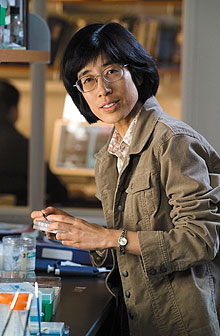  |
| HOME | THIS ISSUE | CALENDAR | GRANTS | BACK ISSUES | < BACK | NEXT > |
Neurobiologist recognized for research on brain cells by Cindy Weiss - February 23, 2009 |
||||
| Akiko Nishiyama, associate professor of physiology and neurobiology, is an unlikely iconoclast. She is a quiet presence in her own busy laboratory group of postdoctoral fellows, graduate students, research assistants, and undergraduate researchers. But after years of struggling to get her ideas and papers accepted, she is now gaining recognition for her research on cells in the brain. Her invited lead review paper in the January 2009 issue of Nature Reviews Neuroscience covers the state of research into NG2 cells, a type of glial cell in the central nervous system that she began studying more than 20 years ago. Once described as housekeeping cells that support neurons and remove debris, glial cells are now thought to have a much more active role in the brain and spinal cord. There are many more of them than neurons in the brain. Nishiyama has been at the forefront of scientists who have found that one type of glial cell, NG2, gives rise to another type that makes insulating sheaths – myelin – around neurons. NG2 cells are a little like stem cells in that way, says Nishiyama, who also has a grant from the state’s stem cell initiative. It is debatable, however, whether NG2 cells, like stem cells, are multipotent – able to give rise to many other types of cells – or whether they have an unlimited ability to renew themselves. Their role as precursors to myelin-producing glial cells leads to potential applications in treating disease. Multiple sclerosis, for example, destroys myelin. While Nishiyama has championed the study of NG2 cells, even giving them a new name, polydendrocytes, her interest in them is based on careful observation that has sometimes challenged accepted concepts. Twenty years ago, Nishiyama was a postdoctoral fellow with William Stallcup in La Jolla, Calif., at what is now called the Burnham Institute. Stallcup’s lab had been the first to isolate the NG2 molecule, around 1980, and the first to discover that it is expressed by cells in the brain. Nishiyama’s contribution was to clone it, identify its primary structure, and characterize the cells in the brain that express NG2. The first time she presented a paper on the existence of NG2 cells in the normal adult brain, Nishiyama recalls, people dismissed her results as an artifact. The second time, some wanted to test her ideas. It took five years to gain credibility. “We had struggled to get our papers accepted,” she says. Prevailing opinion can be daunting for young scientists, she notes. She recalls how one of her students did experiments over several months but did not see neurons being generated from NG2 cells, as many scientists in the field would have expected.
“I cannot see neurons. What should I do?” she asked Nishiyama. “I had to convince her each time that what she was seeing was the real truth, as long as she had taken all the necessary controls and done the experiments correctly,” Nishiyama says. An experiment that Nishiyama’s lab at UConn developed with transgenic mice was critical to establishing that NG2 cells are progenitors to oligodendrocytes, the glial cells that provide neurons with insulating sheaths. This dispelled the false but popular myth that NG2 cells also generate neurons. With the help of Steve Clark, professor of genetics at the UConn Health Center, Nishiyama began generating transgenic mice in 1998, shortly after she arrived at UConn. She had previously conducted research at the Cleveland Clinic Foundation, in a group studying multiple sclerosis. She has since developed several mouse lines that have a fluorescent marker in their NG2 cells and in all the cells that develop from them. When the marker shows up in oligodendrocytes in the mice, it is clear that the fluorescent oligodendrocytes developed from the fluorescent NG2 cells. These experiments provided the first concrete evidence of the role of NG2 cells. Previously, scientists had done Petri dish experiments on NG2 cells and theorized that they gave rise to oligodendrocytes. Nishiyama attended medical school in Japan, earning an MD and training as a neuropathologist. Halfway through her residency, she decided that she wanted to learn more about the mechanism of the disease process, so she switched to a molecular neurobiology lab for her Ph.D. degree. She worked at the Cleveland Clinic Foundation before coming to UConn. Her research is supported by the National Science Foundation, the National Multiple Sclerosis Society, the National Institutes of Health, the Wadsworth Foundation, and the Connecticut Stem Cell Research Program. While she now reviews grants and papers nationally and oversees a large research group, her first love remains experimental work. “I consider experiments as a simple and direct dialogue with nature,” she adds. “You ask nature a question in a way that you will get a meaningful, interpretable answer, and you want to witness the delivery of nature’s response yourself, not through an interpreter.” |
| ADVANCE HOME |

